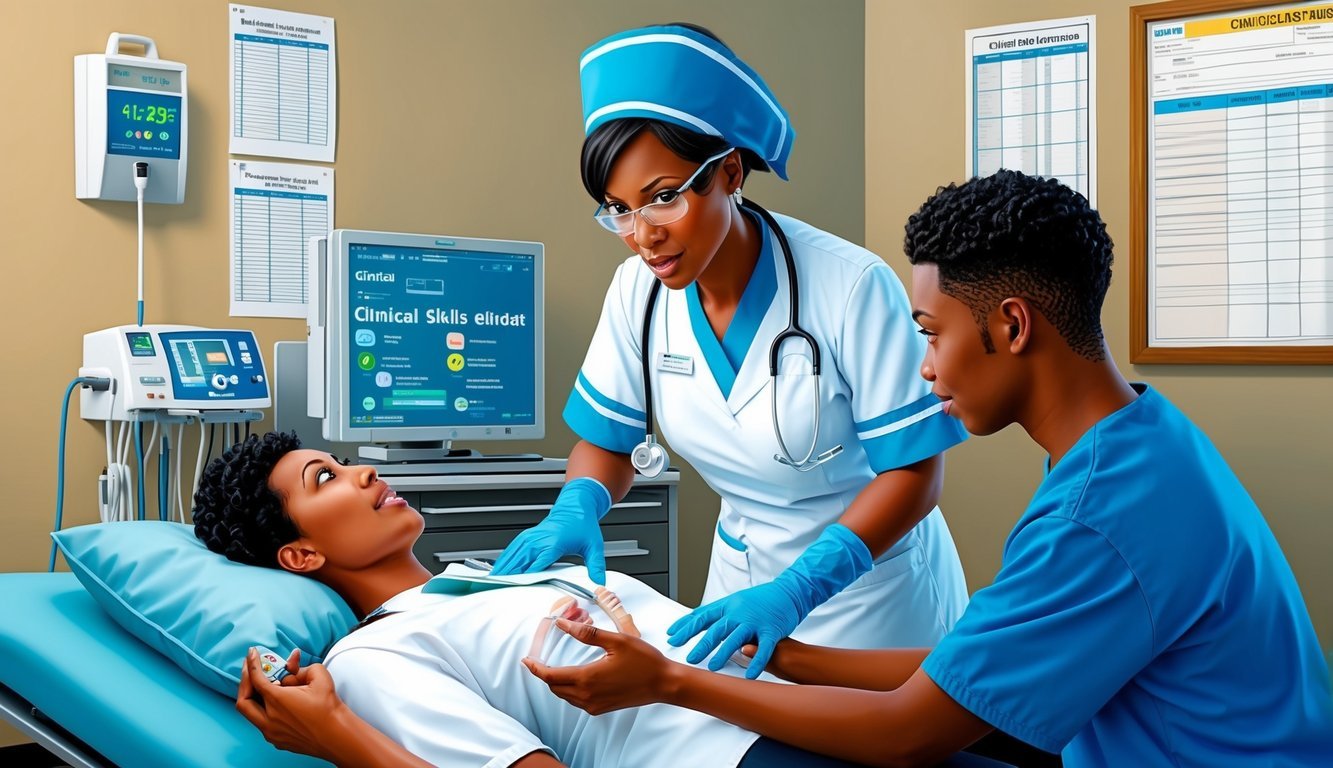Becoming a Licensed Practical Nurse (LPN) is an excellent choice for those looking to embark on a rewarding career in healthcare.
To become an LPN, you must complete an accredited practical nursing program and pass the NCLEX-PN exam.
This process typically takes about a year, making it a relatively quick pathway into the nursing profession.
As an LPN, you will provide essential care to patients in various settings, from hospitals to nursing homes.
Your responsibilities will include monitoring patient health, administering medications, and assisting with daily activities.
For those aspiring to advance their careers, gaining experience as an LPN can open doors to further nursing education or specialty certifications.
To get started on your journey, you should research accredited programs in your area and understand the licensing requirements specific to your state.
Resources like the National Council of State Boards of Nursing can provide you with additional guidance as you navigate this fulfilling career path.
Understanding the LPN Role
The role of a Licensed Practical Nurse (LPN) is vital in the healthcare system.
You will be directly involved in patient care, as well as collaborating with other healthcare professionals to deliver comprehensive support to patients.
Licensed Practical Nurse (LPN) vs Licensed Vocational Nurse (LVN)
The terms LPN and LVN are often used interchangeably.
The primary difference lies in terminology rather than function.
LPN is the designation used in most states, while LVN is used in Texas and California.
| Term | Description |
|---|---|
| LPN | Licensed Practical Nurse |
| LVN | Licensed Vocational Nurse |
Both roles require completing an accredited program and passing the NCLEX-PN exam.
Your responsibilities and scope of practice will be similar regardless of the title.
LPN Responsibilities and Nursing Care
As an LPN, your responsibilities will include delivering essential patient care.
You will monitor patients’ vital signs, assist with daily activities, and administer medications.
Key responsibilities include:
- Nursing assessments: Checking patient conditions and reporting changes.
- Patient care: Aiding with hygiene, mobility, and nutrition.
- Documentation: Keeping accurate patient records.
- Support: Collaborating with RNs and doctors for comprehensive care plans.
By fulfilling these duties, you provide critical assistance to the healthcare team and positively impact patient outcomes.
For more information about LPN responsibilities, you can explore this guide on nursing care.
Educational Pathways
To become a Licensed Practical Nurse (LPN), you must navigate specific education pathways.
These pathways include foundational high school requirements, formal LPN programs, and ensuring your education is achieved through accredited programs.
High School Preparation and GED
Before enrolling in an LPN program, you need a High School Diploma or GED.
This credential is essential as it lays the groundwork for further nursing education.
You should focus on science courses like biology and chemistry, as these subjects are integral to nursing.
In addition to core academic subjects, skills in mathematics and communication are crucial.
They will aid in understanding medication dosages and effectively interacting with patients and healthcare professionals.
If you did not complete high school, obtaining a GED can be an important step.
Many community colleges accept a GED for admission into LPN programs.
LPN Programs and Nursing Education
LPN programs are often offered at community colleges or vocational schools and generally take about 12 months to complete.
These programs include both classroom instruction and clinical practice, so you gain hands-on experience.
Key components of LPN programs often cover:
- Anatomy and physiology
- Nursing fundamentals
- Patient care
- Pharmacology
Upon completion, you will be eligible to sit for the NCLEX-PN exam, which is necessary for licensure.
Choosing programs that operate with a nursing diploma can provide a pathway to further education, such as transitioning to an RN program in the future.
Accreditation of Nursing Programs
When selecting an LPN program, ensure it is an accredited practical nursing program.
Accreditation signifies that the program meets certain educational standards necessary for effective nursing education.
Accrediting bodies, such as the Accreditation Commission for Education in Nursing (ACEN), evaluate programs to ensure quality.
Enrolling in an accredited program enhances your job prospects and ensures eligibility for federal financial aid.
Verify the program’s accreditation status before applying.
Accreditation affects your ability to transfer credits if you decide to continue your education later.
You can review accredited programs through resources like the U.S. Department of Education.
Licensure and Certification
Obtaining your licensure and certification is a crucial step in becoming a Licensed Practical Nurse (LPN).
This process includes passing the NCLEX-PN Examination, understanding state-specific licensure requirements, and maintaining your credentials through continuing education.
The NCLEX-PN Examination
The NCLEX-PN is the national licensing exam for practical nurses.
It evaluates your knowledge and skills essential for safe and effective nursing practice.
You must register for the exam through the National Council of State Boards of Nursing (NCSBN) and pay the associated fees.
The test utilizes adaptive testing technology, adjusting the question difficulty based on your performance.
To pass, you need to answer a minimum of 85 questions, while the maximum is 205.
The topics covered include:
- Safe and effective care environment
- Health promotion and maintenance
- Psychosocial integrity
- Physiological integrity
For more information, visit the NCSBN website.
State Licensure Requirements
Licensure requirements can vary significantly by state.
After passing the NCLEX-PN, you must apply for licensure through your state’s nursing board.
Common steps include submitting proof of your nursing program completion and passing a criminal background check.
Some states may require additional exams or continuing education for initial licensure.
It’s essential to check the specific requirements for your state.
Resources such as the Nurse Licensure Compact (NLC) allow for easier interstate practice for nurses in participating states.
Maintaining Licensure through Continuing Education
After obtaining your licensure, you must maintain it through continuing education.
Most states require LPNs to complete a certain number of continuing education units (CEUs) within a specified timeframe.
Courses can cover various topics, including:
- Advanced patient care techniques
- Updates in nursing practices
- Legal and ethical issues in nursing
Failure to complete these requirements can result in license suspension.
Stay informed about your state’s specific CE requirements, which you can find on your state nursing board’s website.
Clinical Experience and Skills Development

Gaining clinical experience and developing essential nursing skills are critical components of your education as an LPN.
Practical training not only enhances your theoretical knowledge but also prepares you for real-world patient interactions and care management.
Hands-On Training in LPN Programs
During your LPN program, hands-on training is vital for mastering clinical skills.
Most programs include a clinical component where you work alongside licensed nurses in healthcare settings.
You will experience various patient care scenarios, allowing you to apply nursing fundamentals in real life.
This training focuses on developing skills such as:
- Patient assessment
- Basic nursing procedures
- Communication with patients and families
Your ability to perform these tasks confidently relies on this hands-on experience.
Clinical practice provides a safe environment for you to refine your techniques under supervision, ensuring that you are well-prepared for your licensing exam and subsequent nursing roles.
Administering Medication and Monitoring Vital Signs
Medication administration and vital sign monitoring are core responsibilities for LPNs.
During your training, you will learn about pharmacology, including types of medications, dosages, and potential side effects.
You will practice administering medications through various routes, such as oral, intramuscular, or intravenous.
Precision in these tasks is crucial, as errors can impact patient safety.
Monitoring vital signs — including blood pressure, heart rate, temperature, and respiratory rate — allows you to assess a patient’s condition accurately.
Understanding normal ranges and recognizing deviations are essential for timely interventions, ensuring optimal patient care.
Specialized Areas of Nursing
As you progress in your training, you may choose to focus on specialized areas of nursing, such as gerontology or palliative care.
These specialties allow you to develop targeted skills to meet the unique needs of specific patient populations.
For instance, in gerontology, you will learn about common health issues in older adults and how to provide compassionate, comprehensive care.
In palliative care, your focus will shift to enhancing the quality of life for patients with serious illnesses, where effective communication and empathy are paramount.
Specializing can enhance your skill set and potentially increase your employment opportunities in various healthcare settings.
Career Advancement and Opportunities

As a Licensed Practical Nurse (LPN), understanding the various pathways for career advancement can significantly enhance your professional journey.
Several options exist, from transitioning to registered nursing roles to pursuing further education.
Exploring these paths enables you to maximize your potential and earning capacity.
LPN to RN Pathways
Transitioning from LPN to RN is a common and strategic move for many nursing professionals.
The two primary pathways are the Associate Degree in Nursing (ADN) and the Bachelor of Science in Nursing (BSN).
Program Details
| Pathway | Duration | Key Outcomes |
|---|---|---|
| LPN to ADN | 1-2 years | Become an RN with an ADN |
| LPN to BSN | 2-4 years | Earn a BSN for broader career options |
Each program has specific admission requirements, often including a valid LPN license and completion of prerequisite courses. Financial aid options are often available, allowing you to assess cost-effective pathways for furthering your education.
Continued Education for LPNs
Continued education is essential for career growth.
Various programs offer specialized training to enhance your skill set.
Certifications in areas such as geriatrics, pediatrics, or IV therapy can position you for higher-paying roles.
Key Opportunities
- Certification Programs: Options include becoming a Certified Medication Aide or seeking training in specialized nursing areas.
- Advanced Courses: Consider enrolling in courses that prepare you for management roles or specialized medical fields.
Continued education can lead to better job prospects and increased salary potential, allowing you to stay competitive in the evolving healthcare environment.
Utilizing resources like the Bureau of Labor Statistics can provide insights into trends in nursing jobs and salary expectations.
LPN Employment Sectors
LPNs have a variety of employment options across multiple sectors.
Common sectors include:
- Nursing Homes: Focused on long-term care and assistance for elderly patients.
- Physician Offices: Providing support in outpatient settings, where LPNs often assist with patient care and administration.
Sector Comparison
| Sector | Typical Role Responsibilities | Average Salary |
|---|---|---|
| Nursing Homes | LPNs provide patient care and administer medications. | $54,620 annually |
| Physician Offices | LPNs assist in patient exams and office management. | $59,627 annually |
Exploring these sectors can help you find your ideal work environment while enhancing your career trajectory.
You can determine which setting aligns best with your career goals and personal interests by exploring job opportunities in various settings.

